lock CHEVROLET CAMARO 1967 1.G Chassis Workshop Manual
[x] Cancel search | Manufacturer: CHEVROLET, Model Year: 1967, Model line: CAMARO, Model: CHEVROLET CAMARO 1967 1.GPages: 659, PDF Size: 114.24 MB
Page 308 of 659

ENGINE COOLING 6K-3
Fig.
2— Replacing Thermostat
Water Pump
Removal
1.
Drain radiator and break loose the fan pulley bolts.
2.
Disconnect heater hose, lower radiator hose and
by pass hose (as required) at water pump.
3.
Loosen Delcotron and remove fan belt then remove
fan bolts, fan and pulley.
4.
Remove pump to cylinder block bolts and remove
pump from engine.
NOTE:
On in line engines, pull the pump
straight out of the block first, to avoid damage
to impeller.
Installation
1.
Install pump assembly on cylinder block and tighten
bolts securely. Use on new pump to block gasket(s).
2.
Install pump pulley and fan on pump hub and tighten
bolts securely.
NOTE:
A guide stud (5/16"-24 x 1-1/2" bolt
with the head removed) installed in one hole of
the fan hub will aid in aligning hub, pulley and
fan.
Remove stud after starting the remaining
three bolts.
3.
Connect hoses and fill cooling system.
4.
Install fan belt and adjust as previously outlined.
5. Start engine and check for leaks.
CHEVROLET CHASSIS SERVICE MANUAL
Page 312 of 659

ENGINE FUEL 6M-4
Fig.
3C-Fuel Level Sight Plug
2.
Push hand choke knob in to within 1/8" of instru-
ment panel.
3.
Loosen choke cable clamp at carburetor bracket and
adjust cable through the clip until the choke valve
is wide open.
4.
Tighten cable clamp at carburetor bracket and check
operation of choke valve to ensure full closed and
wide open positions.
5. Install air cleaner.
Float Adjustment
Ho/fey (Model 4150
Center
Inlet & Model 2300)
1.
Remove air cleaner then remove the fuel level sight
plugs (Fig. 3c)
2.
With parking brake on, and transmission in neutral,
start the engine and allow it to idle.
3.
With the car on a level surface, the fuel level should
be on a level with the threads at the bottom of the
sight plug port (plus or minus 1/32 inch).
NOTE:
No float drop adjustment is required
on this carburetor.
4.
If necessary to adjust (either or both bowls), loosen
inlet needle lock screw and turn the adjusting nut
clockwise to lower or counter-clockwise to raise
fuel level, then tighten lock screw.
NOTE:
1/6 turn of adjusting nut equals ap-
proximately 1/16" fuel level change.
5. Allow a minute for fuel level to stabilize then re-
check the level at sight plug.
6. Readjust, if necessary, until proper level is obtained,
then install sight plug and air cleaner.
NOTE:
To assure proper secondary float level
setting it is advisable to accelerate primary
throttles slightly and hand operate secondary
throttle. This assures a stabilized secondary
fuel level.
Additional Adjustments
The following adjustments may be made without re-
moving the carburetor from the engine. For procedure
refer to Section 6M of the Overhaul Manual under the
carburetor being serviced.
Rochester BV
• Float
• Idle Vent
• Choke Rod (Fast Idle)
• Choke Vacuum Break
• Choke Unloader
Rochester 2GV
• Float
• Accelerator Pump
• Idle Vent
• Choke Rod (Fast Idle)
• Choke Vacuum Break
• Choke Unloader
• Secondary Throttle Opening
• Secondary Throttle Lockout
Rochester 4MV
• Float
• Accelerator Pumj)
• Idle Vent
• Air Valve
• Choke Rod
• Choke Vacuum Break
• Choke Unloader
• Air Valve Lockout
• Secondary Opening
• Secondary Lockout
Carter YF
• Float
• Idle Vent
• Choke Rod (Fast Idle)
• Choke Vacuum Break
• Choke Unloader
Holley 4160 and 4150
(Except End
Inlet)
• Float
• Air Vent Valve
• Accelerator Pump
• Choke Vacuum Break
• Choke Unloader
Holley 2300 and 4150
(End
Inlet)
• Air Vent Valve (except 2300)
• Accelerator Pump
• Choke Vacuum Break
• Choke Unloader
Removal
Flooding, stumble on acceleration and other perform-
mance complaints are, in many instances, caused by the
presence of dirt, water, or other foreign matter in the
carburetor. To aid in diagnosing the cause of the com-
plaint, the carburetor should be carefully removed from
the engine without draining the fuel from the bowl.
The contents of the fuel bowl may then be examined for
contamination as the carburetor is disassembled.
1.
Remove air cleaner and gasket.
2.
Disconnect fuel and vacuum lines from carburetor.
CHEVROLET CHASSIS SERVICE MANUAL
Page 325 of 659

AIR INJECTOR REACTOR SYSTEM 6T-5
LEGS LOCK
ON
INSIDE SURFACE
/
BLUE-194,
230
SILVER-250
GREEN-283
BLACK-327,
350, 396 & 427
PRESSURE
RELIEF VALVE
Fig.
7—Installing Pressure Relief Valve
Fig.
8—Pressure Setting Plug
pressure required to open the relief valve. For
identification, the pressure setting plugs are
color coded. To remove the pressure setting
plug, carefully unlock legs from inside surface
of relief valve with a small screw, driver. To
install the pressure setting plug, carefully push
into relief valve until legs lock. If a pressure
setting plug is to be reused be sure leg angles
are sufficient for the pressure setting plug to
lock in place.
SPECIAL TOOLS
J-7055-5
J-6585
J-21844
J-21058
Fig.
9-Special Tools
CHEVROLET CHASSIS SERVICE MANUAL
Page 331 of 659
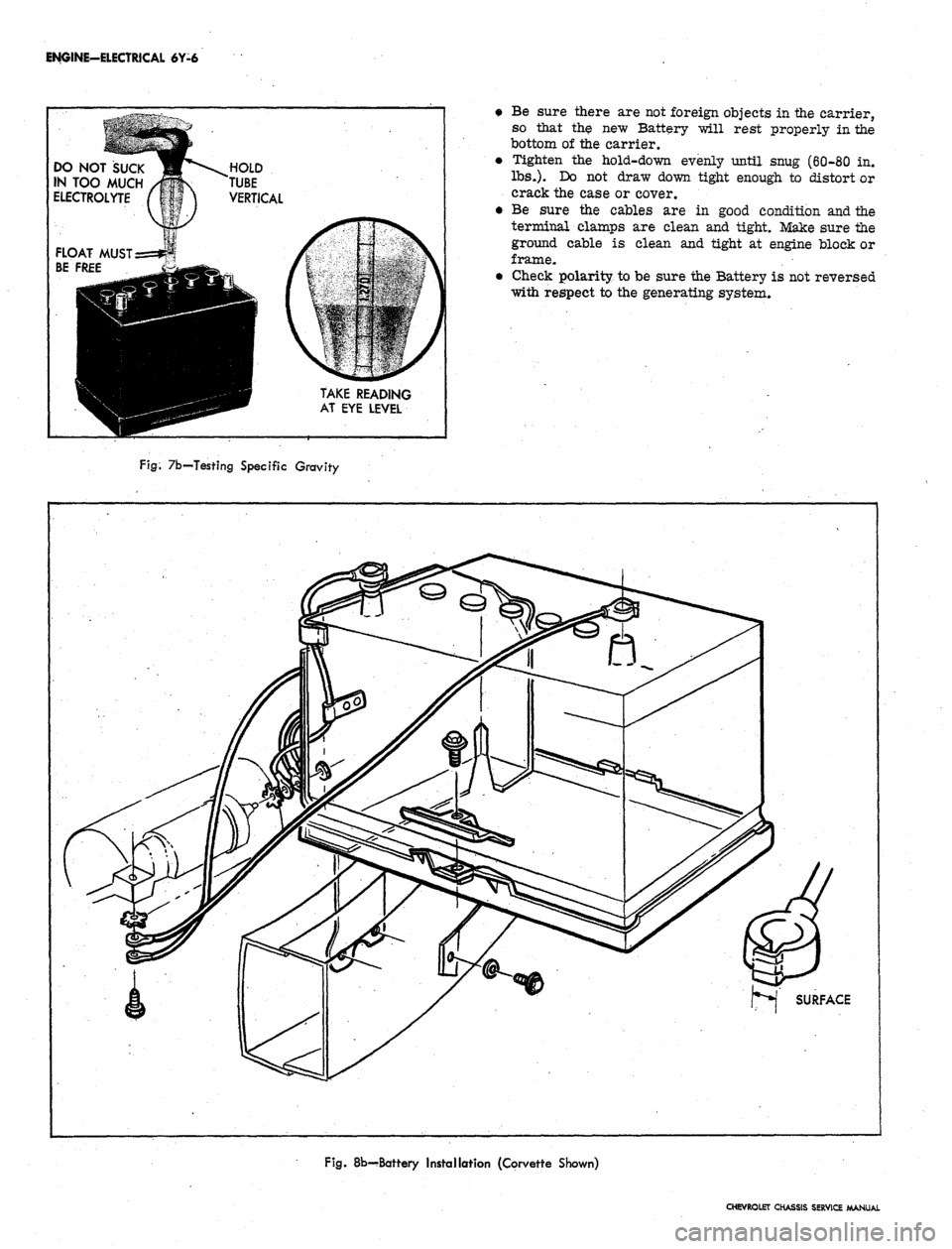
ENGINE-ELECTRICAL 6Y-6
DO NOT SUCK
IN TOO MUCH
ELECTROLYTE
FLOAT MUST
BE FREE
TAKE READING
AT EYE LEVEL
• Be sure there are not foreign objects in the carrier,
so that the new Battery will rest properly in the
bottom of the carrier.
• Tighten the hold-down evenly until snug (60-80 in.
lbs.).
Do not draw down tight enough to distort or
crack the case or cover.
• Be sure the cables are in good condition and the
terminal clamps are clean and tight. Make sure the
ground cable is clean and tight at engine block or
frame.
• Check polarity to be sure the Battery is not reversed
with respect to the generating system.
Fig.
7b—Testing Specific Gravity
Fig.
8b--Battery Installation (Corvette Shown)
CHEVROLET CHASSIS SERVICE MANUAL
Page 333 of 659
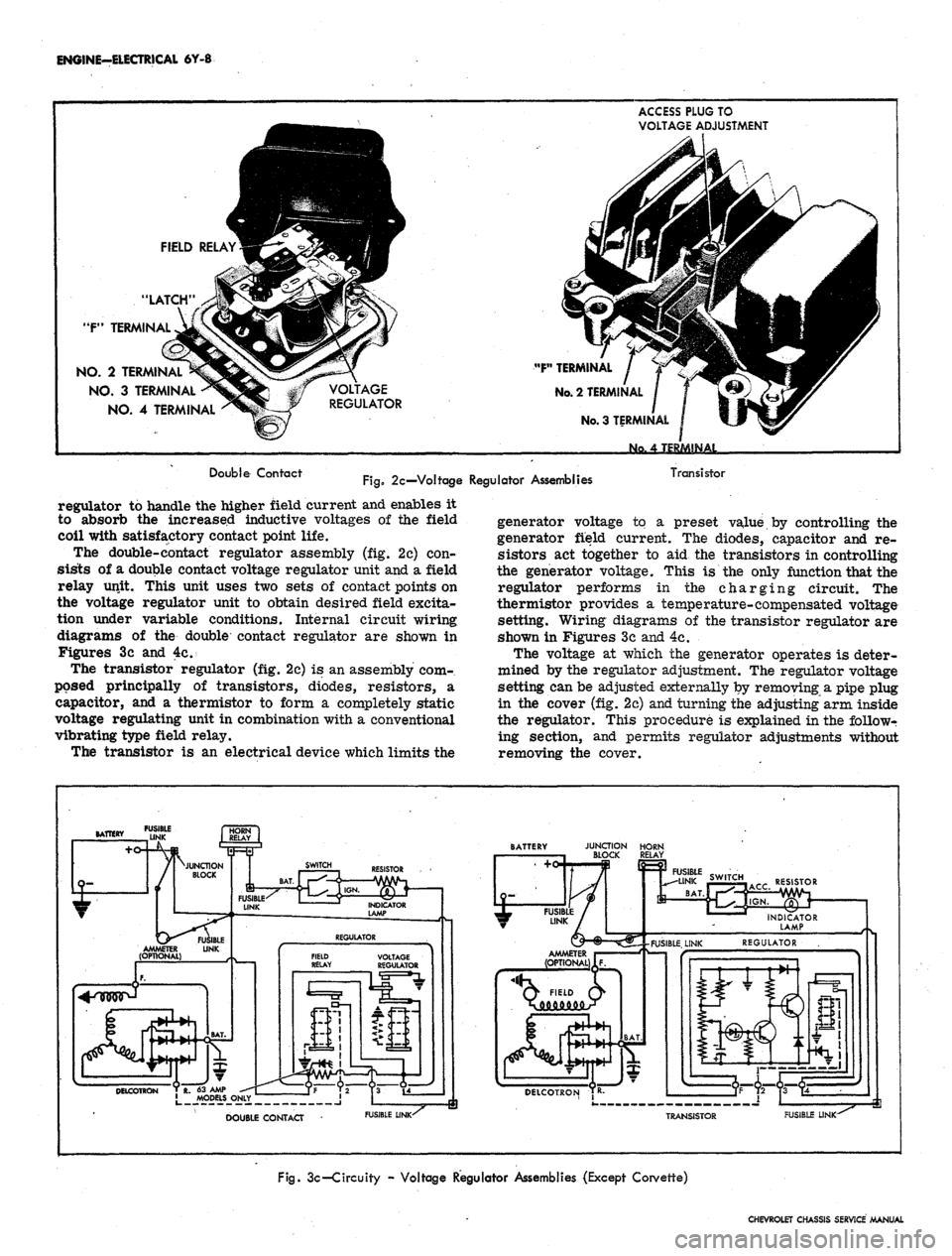
ENGINE-ELECTRICAL 6Y-8
1
FIELD RELAY^I^p2
"LATCH"
^PFN?^
"P1
TERMINAL
JyJvJCTl^
NO. 2 TERMINAD^5^^^«
NO.
3 TERMINAL ^S5«£
NO.
4 TERMINAL ^^^
m
# / VOLTAGE
¥ REGULATOR
1
ACCESS PLUG TO
VOLTAGE ADJUSTMENT
No 4 TERMINAL
Double Contact
Fig.
2c—Voltage Regulator Assemblies
Transistor
regulator to handle the higher field current and enables it
to absorb the increased inductive voltages of the field
coil with satisfactory contact point life.
The double-contact regulator assembly (fig. 2c) con-
sists of a double contact voltage regulator unit and a field
relay unit. This unit uses two sets of contact points on
the voltage regulator unit to obtain desired field excita-
tion under variable conditions. Internal circuit wiring
diagrams of the double contact regulator are shown in
Figures 3c and 4c.
The transistor regulator (fig. 2c) is an assembly com-
posed principally of transistors, diodes, resistors, a
capacitor, and a thermistor to form a completely static
voltage regulating unit in combination with a conventional
vibrating type field relay.
The transistor is an electrical device which limits the
generator voltage to a preset value by controlling the
generator field current. The diodes, capacitor and re-
sistors act together to aid the transistors in controlling
the generator voltage. This is the only function that the
regulator performs in the charging circuit. The
thermistor provides a temperature-compensated voltage
setting. Wiring diagrams of the transistor regulator are
shown in Figures 3c and 4c.
The voltage at which the generator operates is deter-
mined by the regulator adjustment. The regulator voltage
setting can be adjusted externally by removing a pipe plug
in the cover (fig. 2c) and turning the adjusting arm inside
the regulator. This procedure is explained in the followr
ing section, and permits regulator adjustments without
removing the cover.
FUSIBLE
DOUBLE CONTACT
FUSIBLE LINK-^
JUNCTION HORN
BLOCK RELAY
RESISTOR
Q FIELD Q>
DELCOTRON TR-
TRANSISTOR
FUSIBLE LINK-
Fig.
3c-Circuity - Voltage Regulator Assemblies (Except Corvette)
CHEVROLET CHASSIS SERVICE MANUAL
Page 334 of 659
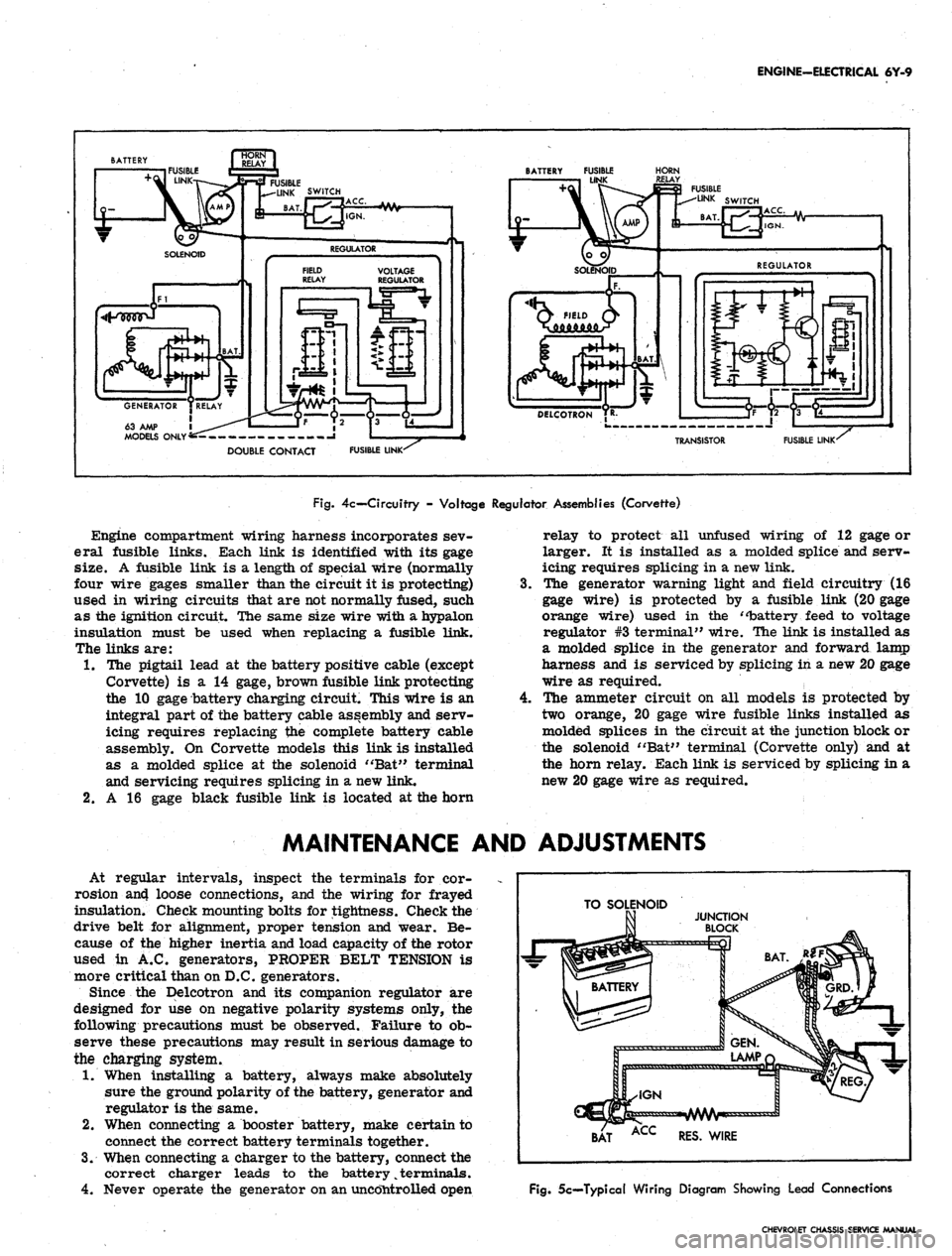
ENGINE-ELECTRICAL 6Y-9
63 AMP 1
MODELS ONLY'
BATTERY FUSIBLE
LINK
HORN
FUSIBLE LINK'
TRANSISTOR
FUSIBLE LINK'
Fig.
4c— Circuitry - Voltage Regulator Assemblies (Corvette)
Engine compartment wiring harness incorporates sev-
eral fusible links. Each link is identified with its gage
size. A fusible link is a length of special wire (normally
four wire gages smaller than the circuit it is protecting)
used in wiring circuits that are not normally fused, such
as the ignition circuit. The same size wire with a hypalon
insulation must be used when replacing a fusible link.
The links are:
1.
The pigtail lead at the battery positive cable (except
Corvette) is a 14 gage, brown fusible link protecting
the 10 gage battery charging circuit. This wire is an
integral part of the battery cable assembly and serv-
icing requires replacing the complete battery cable
assembly. On Corvette models this link is installed
as a molded splice at the solenoid "Bat" terminal
and servicing requires splicing in a new link.
2.
A 16 gage black fusible link is located at the horn
4.
relay to protect all unfused wiring of 12 gage or
larger. It is installed as a molded splice and serv-
icing requires splicing in a new link.
The generator warning light and field circuitry (16
gage wire) is protected by a fusible link (20 gage
orange wire) used in the "battery feed to voltage
regulator #3 terminal" wire. The link is installed as
a molded splice in the generator and forward lamp
harness and is serviced by splicing in a new 20 gage
wire as required.
The ammeter circuit on all models is protected by
two orange, 20 gage wire fusible links installed as
molded splices in the circuit at the junction block or
the solenoid "Bat" terminal (Corvette only) and at
the horn relay. Each link is serviced by splicing in a
new 20 gage wire as required.
MAINTENANCE AND ADJUSTMENTS
At regular intervals, inspect the terminals for cor-
rosion an4 loose connections, and the wiring for frayed
insulation. Check mounting bolts for tightness. Check the
drive belt for alignment, proper tension and wear. Be-
cause of the higher inertia and load capacity of the rotor
used in A.C. generators, PROPER BELT TENSION is
more critical than on D.C. generators.
Since the Delcotron and its companion regulator are
designed for use on negative polarity systems only, the
following precautions must be observed. Failure to ob-
serve these precautions may result in serious damage to
the charging system.
1.
When installing a battery, always make absolutely
sure the ground polarity of the battery, generator and
regulator is the same.
2.
When connecting a booster battery, make certain to
connect the correct battery terminals together.
3.
When connecting a charger to the battery, connect the
correct charger leads to the battery
%
terminals.
4.
Never operate the generator on an uncontrolled open
TO SOLENOID
BAT ACC RES. WIRE
Fig.
5c—Typical Wiring Diagram Showing Lead Connections
CHEVROLET CHASSIS SERVICE MANUAL
Page 335 of 659
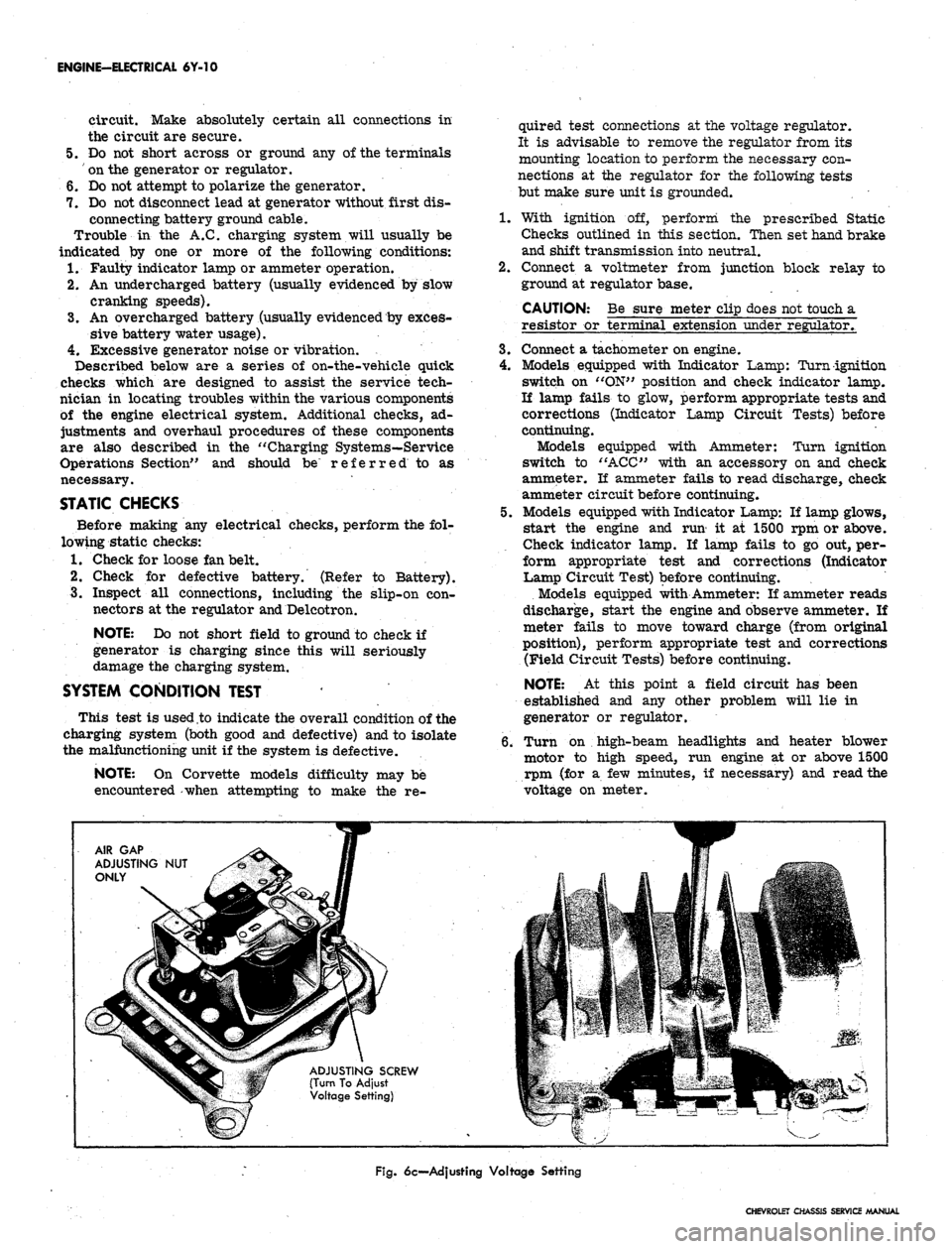
ENGINE-ELECTRICAL 6Y-10
circuit. Make absolutely certain all connections in
the circuit are secure.
5.
Do not short across or ground any of the terminals
on the generator or regulator.
6. Do not attempt to polarize the generator.
7.
Do not disconnect lead at generator without first dis-
connecting battery ground cable.
Trouble in the A.C. charging system will usually be
indicated by one or more of the following conditions:
1.
Faulty indicator lamp or ammeter operation.
2.
An undercharged battery (usually evidenced by slow
cranking speeds).
3.
An overcharged battery (usually evidenced by exces-
sive battery water usage).
4.
Excessive generator noise or vibration.
Described below are a series of on-the-vehicle quick
checks which are designed to assist the service tech-
nician in locating troubles within the various components
of the engine electrical system. Additional checks, ad-
justments and overhaul procedures of these components
are also described in the "Charging Systems—Service
Operations Section" and should be referred to as
necessary.
STATIC CHECKS
Before making any electrical checks, perform the fol-
lowing static checks:
1.
Check for loose fan belt.
2.
Check for defective battery. (Refer to Battery).
3.
Inspect all connections, including the slip-on con-
nectors at the regulator and Delcotron.
NOTE: Do not short field to ground to check if
generator is charging since this will seriously
damage the charging system.
SYSTEM CONDITION TEST
This test is used .to indicate the overall condition of the
charging system (both good and defective) and to isolate
the malfunctioning unit if the system is defective.
NOTE: On Corvette models difficulty may be
encountered -when attempting to make the re-
quired test connections at the voltage regulator.
It is advisable to remove the regulator from its
mounting location to perform the necessary con-
nections at the regulator for the following tests
but make sure unit is grounded.
1.
With ignition off, perform the prescribed Static
Checks outlined in this section. Then set hand brake
and shift transmission
into
neutral.
2.
Connect a voltmeter from junction block relay to
ground at regulator base.
CAUTION: Be sure meter clip does not touch a
resistor or terminal extension under regulator,
3.
Connect a tachometer on engine.
4.
Models equipped with Indicator Lamp: Turn ignition
switch on "ON" position and check indicator lamp.
If lamp fails to glow, perform appropriate tests and
corrections (Indicator Lamp Circuit Tests) before
continuing.
Models equipped with Ammeter: Turn ignition
switch to "ACC" with an accessory on and check
ammeter. If ammeter fails to read discharge, check
ammeter circuit before continuing.
5.
Models equipped with Indicator Lamp: If lamp glows,
start the engine and run' it at 1500 rpm or above.
Check indicator lamp. If lamp fails to go out, per-
form appropriate test and corrections (Indicator
Lamp Circuit Test) before continuing.
Models equipped with Ammeter: If ammeter reads
discharge, start the engine and observe ammeter. If
meter fails to move toward charge (from original
position), perform appropriate test and corrections
(Field Circuit Tests) before continuing.
NOTE: At this point a field circuit has been
established and any other problem will lie in
generator or regulator.
6. Turn on high-beam headlights and heater blower
motor to high speed, run engine at or above 1500
rpm (for a few minutes, if necessary) and read the
voltage on meter.
AIR GAP
ADJUSTING NUT
ONLY
ADJUSTING SCREW
(Turn To Adjust
Voltage Setting)
Fig.
6c—Adjusting Voltage Setting
CHEVROLET CHASSIS SERVICE MANUAL
Page 336 of 659

ENGINE-ELECTRICAL 6Y-11
I
BAT
JUNCTION BLOCK
DELCOTRON
—GRQ
BATTERY
&HJVVWV
0 VA OHM TEST RELAY >
RESISTOR [ 1 d
FUSIBLE
LINK
TO CRANKING
MOTOR
Ik
REGULATOR
VOLTMETER
FUSIBLE LINK
IGN.
SWITCH
Fig.
7c—Voltage Setting Test Connections
NOTE:
Voltage will not greatly exceed 12-1/2
volts until the battery develops a surface charge,
a few minutes generally, unless the battery is
severely discharged or is hot.
If reading is:
a. 12-1/2 volts or more, turn off electrical loads,
stop engine and proceed to Step 7.
b.
Less than 12-1/2 volts, perform "Delcotron Out-
put Test-Voltmeter Method."
(1) Delcotron tests bad—refer to "Service Op-
erations" and repair Delcotron, then repeat
Step 6.
(2) Delcotron tests good—disconnect regulator
connector, remove regulator cover and recon-
nect the connector. Then repeat Step 6 and
turn voltage adjusting screw (fig. 6c) to raise
setting to 12-1/2 volts. On transistor regula-
tor remove pipe plug (fig. 6c), insert screw
driver into slot and turn clockwise one or two
notches to increase setting. Turning counter-
clockwise decreases setting. For each notch
moved, the voltage setting will change ap-
proximately .3 volt. Turn off loads, stop en-
gine and proceed to Step 7. If 12-1/2 volts
cannot be obtained, install a new regulator and
repeat Step 6.
ADJUSTING REGULATOR VOLTAGE
7. Connect a 1/4 ohm-25 watt fixed resistor (purchased
commercially) into the charging circuit at the junc-
tion block as shown in Figure 7c.
NOTE:
Between both leads and the terminal.
8. Run engine at 1500 rpm or above for at least 15
minutes of warm-up, then cycle regulator voltage
control (by disconnecting and re-connecting regulator
connector) and read voltage.
If voltage is 13.5 to 15.2, the regulator is okay.
If voltage is not within 13.5 to 15.2 volts, leave en-
gine running at 1500 rpm or above and:
a. Disconnect four terminal connector and remove
regulator cover. Then re-connect four terminal
connector and adjust voltage to i4.2 to 14.6.
(Refer to Step 6 and fig. 6c).
b.
Disconnect four terminal connector and reinstall
regulator cover, then reinstall connector.
c. Continue running engine at 1500 rpm for 5-10
minutes to re-establish regulator internal
temperature.
d. Cycle regulator voltage by disconnecting and re-
connecting regulator connector. Read voltage. A
reading between 13.5 and 15.2 indicates a good
regulator.
CAUTION: Be sure four terminal regulator
connector is disconnected when removing or in-
stalling cover. This is to prevent regulator
damage by short circuits.
DELCOTRON OUTPUT TEST
Ammeter Method (Fig. 8c)
1.
Disconnect the battery ground cable at the battery.
2.
Disconnect the red wire at Delcotron battery termi-
nal and connect an ammeter in series between the
wire and terminal.
3.
Connect a voltmeter from battery terminal to a good
ground on the generator.
4.
Disconnect the F-R terminal connector at the
Delcotron.
5. Connect the jumper wire between Delcotron "F" and
battery terminals.
6. Connect the battery ground cable at the battery.
7. Connect an adjustable carbon pile across the battery
posts.
8. Start the engine and slowly bring the speed to 1500
RPM and at the same time adjust the carbon pile
load to hold the voltage at 14 volts.
9. Read the amperage and compare with a specifications
chart.
CHEVROLET CHASSIS SERVICE MANUAL
Page 345 of 659

ENGINE-ELECTRICAL 6Y-20
cause oxidized contact points. Check for these conditions
where burned contacts are experienced. An
out-of-
balance condition in the ignition system, often the result
of too much or too little condenser capacity, is indicated
where point pitting is encountered.
REPLACEMENT
Four and Six Cylinder Engine Distributor
1.
Release distributor cap hold-down screws, remove
cap and place it out of work area.
2.
Remove rotor.
3.
Pull primary and condenser lead wires from contact
point quick disconnect terminal (fig. 4i).
4.
Remove contact set attaching screw, lift contact point
set from breaker plate.
5.
Clean breaker plate of oil smudge and dirt.
6. Place new contact point assembly in position on
breaker plate, install attaching screw.
CAUTION: Carefully wipe protective film from
point set prior to installation.
NOTE: Pilot on contact set must engage match-
ing hole in breaker plate.
7.
Connect primary and condenser lead wires to quick
disconnect terminal on contact point set. .
8. Check and adjust points for proper alignment and
breaker arm spring tension (fig. 5i). Use an aligning
tool to bend stationary contact support if points need
alignment.
NOTE: The contact point pressure must fall
within specified limits. Weak tension will cause
CONTACT SET
ATTACHING
SCREW
QUICK
DISCONNECT
TERMINAL
BREAKER PLATE
ATTACHING SCREWS
chatter, resulting in arcing and burning of-the
points and an ignition miss at high speed, while
excessive tension will cause undue wear of the
contact points, cam and rubbing block. Breaker
arm spring tension should be 19-23 ounces. The
contact point pressure should be checked with a
spring gauge. The scale should be hooked to the
breaker lever and the pull exerted at 90 degrees
to the breaker lever as shown in Figure 5i. The
reading should be taken just as the points sepa-
rate.
The pressure can be adjusted by bending
the breaker lever spring. If the pressure is ex-
cessive, it can be decreased by pinching the
spring carefully. To increase pressure,, the
lever must be' removed from the distributor so
the spring can be bent away from the lever.
Avoid excessive spring distortion.
9. Set point opening (.019" for new points).
10.
Reinstall rotor, position and lock distributor cap to
housing.
11.
$tart engine and test dwell and ignition timing.
Eight Cylinder Engine Distributor
1.
The contact point set is replaced as one complete
assembly and only dwell angle requires adjustment
after replacement. Breaker lever spring tension and
point alignment are factory set.
2.
Remove the distributor cap by placing a screw driver
in the slot head of the latch, press down and turn 1/4
turn in either direction.
3.
Remove the two attaching screws which hold the base
of the contact set assembly in place.
4.
Remove the primary and condenser leads from their
nylon insulated connection (fig. 6i) in contact set.
5.
Reverse Steps 2, 3 and 4 to install new contact set.
CAUTION:. Install the primary and condenser
leads as shown in Figure 6i. Improper installa-
tion will cause lead interference between the
cap,
weight base and breaker advance plate.
6. If car has 20,000 to 25^000 miles (or sooner if
desired) the cam lubricator wick (fig. 7i) should be
changed. Using long nosed pliers squeeze assembly
together at base and lift out. Remove all old lubri-
cant from cam surface. Replace in same manner.
Fig.
4i—Breaker Plate and Attaching Parts
Fig. 5i—-Checking Breaker Arm Spring Tension
CHEVROLET CHASSIS SERVICE MANUAL
Page 346 of 659
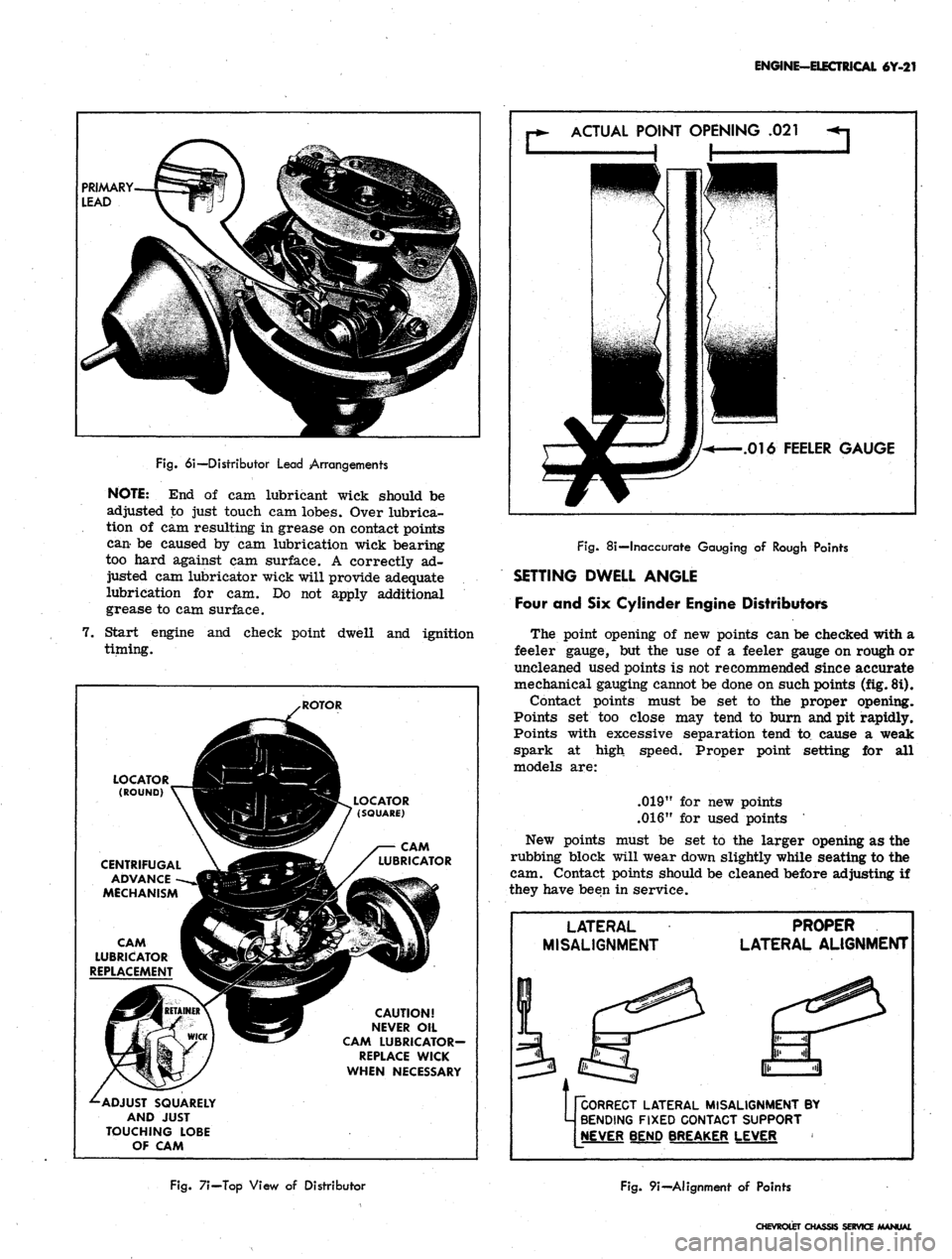
ENGINE-ELECTRICAL
6Y-21
Fig.
6i—Distributor Lead Arrangements
NOTE:
End of cam
lubricant wick should
be
adjusted
to
just touch
cam
lobes. Over lubrica-
tion
of cam
resulting
in
grease
on
contact points
can-
be
caused
by cam
lubrication wick bearing
too hard against
cam
surface.
A
correctly
ad-
justed
cam
lubricator wick will provide adequate
lubrication
for cam. Do not
apply additional
grease
to cam
surface.
7.
Start engine
and
check point dwell
and
ignition
timing.
ACTUAL
POINT OPENING
.021
.016
FEELER GAUGE
LOCATOR ___JH^H
(ROUND)
V~^3H|
CENTRIFUGAL
\
jdft
ADVANCE
-~-»JBlMBl
MECHANISM
«H
CAM g^k. / X
LUBRICATOR
V^^^
REPLACEMENT
^£9
^-ADJUST
SQUARELY
AND
JUST
TOUCHING
LOBE
OF
CAM
.ROTOR
I^^I^BL
LOCATOR
(PBV 7
(SQUARE)
SBSSF
/
WWjga^/
^/
LUBRICATOR
H^f
CAUTION!
S5y
NEVER
OIL
•-^
CAM
LUBRICATOR-
REPLACE
WICK
WHEN
NECESSARY
Fig.
8i—Inaccurate Gauging
of
Rough Points
SETTING DWELL ANGLE
Four
and Six
Cylinder Engine Distributors
The point opening
of new
points
can be
checked with
a
feeler gauge,
but the use of a
feeler gauge
on
rough
or
uncleaned used points
is not
recommended since accurate
mechanical gauging cannot
be
done
on
such points (fig. 8i).
Contact points must
be set to the
proper opening.
Points
set too
close
may
tend
to
burn and
pit
rapidly.
Points with excessive separation tend
to
cause
a
weak
spark
at
high speed. Proper point setting
for all
models
are:
.019"
for new
points
.016"
for
used points
New points must
be set to the
larger opening
as the
rubbing block will wear down slightly while seating
to the
cam. Contact points should
be
cleaned before adjusting
if
they have been
in
service.
LATERAL
MISALIGNMENT
PROPER
LATERAL
ALIGNMENT
pCORRECT
LATERAL MISALIGNMENT
BY
M
BENDING FIXED CONTACT SUPPORT
[NEVER
BEND BREAKER LEVER
Fig.
7i—Top View
of
Distributor
Fig.
9i—Alignment
of
Points
CHEVROLET
CHASSIS SERVICE /MANUAL